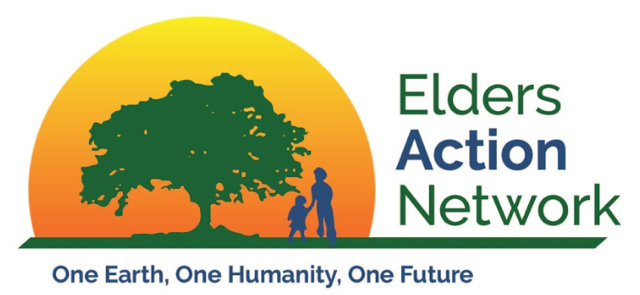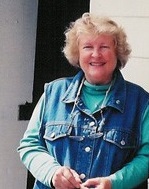
Palo Alto, CA
Climate change, depletion of fisheries, toxic pollution, endangered species. Sometimes it’s enough to make you throw up your hands in despair. “I’m just one person, what difference can I make? What could I do?”
Well, actually one person – one ordinary person – can do quite a lot if she sets her mind to it. If you want proof, just ask Karen Harwell, or better yet, visit her Dana Meadows Children’s Garden. Once it was an ordinary house and yard on an ordinary street, but today it is a humming, buzzing, quacking swirl of life and fragrance and color, and a haven for the neighborhood children.
“It’s not much land – just one sixth of an acre — and I know it’s not going to solve everything, but I figure I live here, on this particular piece of the Earth. It nurtured my family while my sons were growing up, and now I’m experimenting with nurturing it.”
One sixth of an acre – with a four-bedroom house sitting in the center of it – is not a lot of land, but every square inch of exposed soil is part of Karen’s experiment. Every inch is alive with complexity and interconnection. Duck manure fertilizes lemon trees. Honeybees pollinate the avocado blossoms. Mint plants grow in the shade of a wisteria. And all of it is one answer to: “what can one person do?”
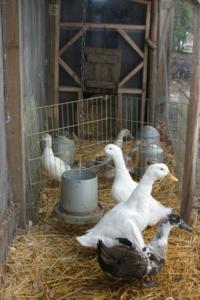
One person can:
Plant 18 semi-dwarf fruit trees – avocados, grapefruits, cherries, pears, lemons, apples, figs. (“So that there will be something ripe every month of the year.”)
Build a pen and fill it with four ducks. Build a tiny pond, for the ducks to swim in.
Every week (with the help of neighborhood kids) empty the pond and pour its rich waters on the fruit trees.
Re-roof the garage with photovoltaic shingles, and then sell electricity back to the grid.
Notice the neighborhood fathers’ fascination with the way the electricity meter spins backwards on sunny days.
On Easter Sunday, join in when the kids invent an “Easter-snail” hunt (with all snails devoted to the feeding of ducks).
Invite the kids over to build wooden flats for seeds when spring arrives.
The next weekend have them back to plant seeds in the flats that they built.
As the season progresses, transplant the children’s seedlings and water and weed and harvest. Do it alone or, if one wanders by, with a child.
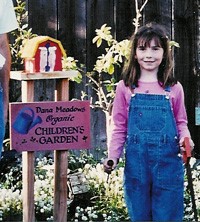 Laugh at herself when she harvests the corn too early one year, and too late the next. Savor it and share it when, the third year, she gets it right.
Laugh at herself when she harvests the corn too early one year, and too late the next. Savor it and share it when, the third year, she gets it right.
Install a hive of honey-bees behind the duck pond.
Stand at the sink before the open window and listen to the kids as they pass through the garden on their way home from school, fresh picked cherries in their hands. “You mean you can come here whenever you want? Without asking?”
Invite the neighbors to a grapefruit tasting session. Smile when one boy says he didn’t even know he liked grapefruit.
Compost kitchen scraps with straw from the duck pen, and sprinkle the finished compost across the herb garden.
Come home to find a note from an eight-year-old neighbor stuck to the door (“I think the cantaloupe is ready to pick”).
Come home to find a message on the answering machine (“I ate the last two plums from the tree. They were soooo good. There must be something to this organic business.”)
Welcome the local newspaper when they want to write a story and take some pictures of the gardens and the children and the ducks.
Become a stop on the “solar home tour.”
Show the world that moving towards sustainability isn’t a chore or a sacrifice or deprivation but a dance of delight, a chance to connect, a way to come to life.
That’s what one person can do (at least for now; she is not finished yet.) One person can create something beautiful, something life-giving.
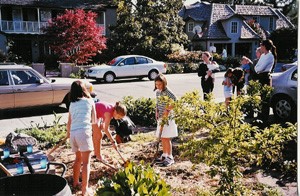 Picture thousands of us, like Karen, answering “what can one person do” with whatever beauty is wanting to come out of us. Not only duck pens and orange blossoms, but also well-tended forests and clear running streams and restaurants serving delicious food from local farms. Imagine also fuel cells and windmills and energy-efficient buses because each of these represents a kind of beauty, too.
Picture thousands of us, like Karen, answering “what can one person do” with whatever beauty is wanting to come out of us. Not only duck pens and orange blossoms, but also well-tended forests and clear running streams and restaurants serving delicious food from local farms. Imagine also fuel cells and windmills and energy-efficient buses because each of these represents a kind of beauty, too.
Now, picture ten-thousand people…
Written by Elizabeth Sawin, this profile was originally published by the Donella Meadows Institute.
